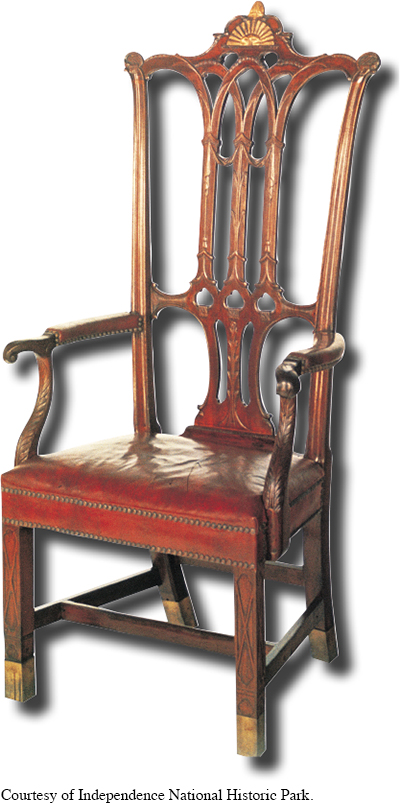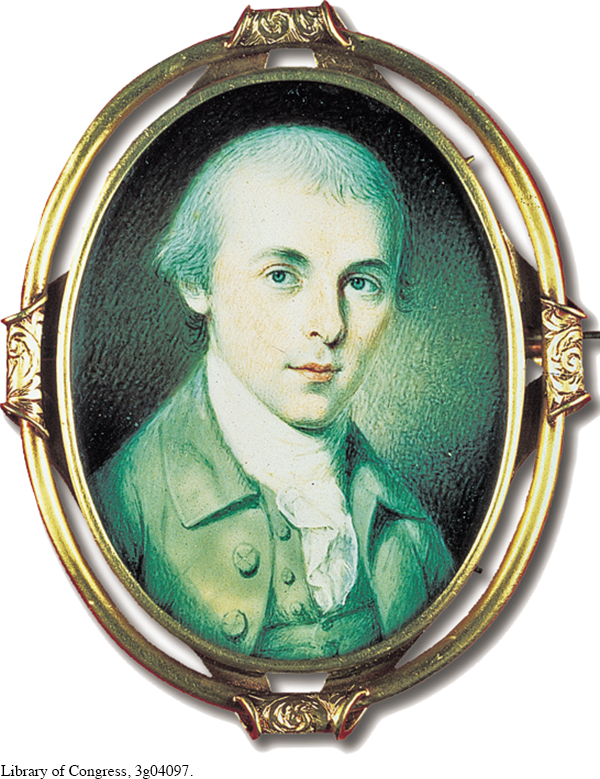The American Promise: Printed Page 195
The American Promise, Value Edition: Printed Page 181
The American Promise: A Concise History: Printed Page 208
Introduction to Chapter 8
8
Building a Republic
1775–
The American Promise: Printed Page 195
The American Promise, Value Edition: Printed Page 181
The American Promise: A Concise History: Printed Page 208
Page 195
CONTENT LEARNING OBJECTIVES
After reading and studying this chapter, you should be able to:
Articulate the concerns of the Second Continental Congress about sovereignty, representation, taxation, and citizenship. Recognize how these concerns shaped the Articles of Confederation.
Explain the role state governments played under the Articles of Confederation. Identify how the differing state governments defined citizenship and handled slavery.
Explain the major issues confronting the new United States to 1788, including how the Articles of Confederation limited the government’s ability to solve these problems.
Understand how the U.S. Constitution was debated and created, and understand the Constitution’s position on slavery.
Distinguish the Federalists and the Antifederalists, and explain their visions for the federal and state governments.
Follow the process by which the U.S. Constitution was ratified, how its proponents secured ratification, and why some people opposed ratification.
JAMES MADISON GRADUATED FROM PRINCETON COLLEGE IN New Jersey in 1771, undecided about his next move. Returning to his wealthy father’s plantation in Virginia held little appeal. He much preferred the pleasures of books to farming. Fluent in Greek, Latin, French, and mathematics, he enjoyed reading and discussing the great thinkers, both ancient and modern. So he stayed in Princeton as long as he could.
In 1772, he returned home, still adrift. He studied law, but his unimpressive oratorical talents discouraged him. Instead, he swapped reading lists and ideas about political theory by letter with a Princeton classmate. While Madison struggled for direction, the powerful winds before the storm of the American Revolution swirled through the colonies. A trip north to deliver his brother to boarding school put Madison in Philadelphia just as news broke that Britain had shut down the port of Boston. Turbulent protests over the Coercive Acts turned the young man into a committed revolutionary.
Back in Virginia, Madison joined his father on the committee of public safety. He took up musket practice, but he proved a poor shot. Realizing that his keen study of political theory was useful, he gained election in 1776 to the Virginia Convention, a new Revolutionary assembly. The convention’s main task was to hammer out a state constitution with innovations such as frequent elections and limited executive power. Shy and still learning the ropes, Madison stayed on the sidelines, but Virginia’s elder statesmen noted his thoughtful contributions. When his county failed to reelect him, he was appointed to the governor’s council and spent the next two years rapidly gaining political experience.
The American Promise: Printed Page 195
The American Promise, Value Edition: Printed Page 181
The American Promise: A Concise History: Printed Page 208
Page 196In 1780, Madison represented Virginia in the Continental Congress. Twenty-

Madison returned to the Virginia assembly in 1784. But he did not retreat to a local point of view held by other state politicians. The economic hardships created by heavy state taxation—
Madison helped organize a convention in May 1787, where delegates completely rewrote the structure of the national government, investing it with considerably greater powers. True to form, Madison spent the months before that Philadelphia meeting in feverish study of the great thinkers he had read in college, seeking the best way to constitute a government on republican principles. His lifelong passion for scholarly study, seasoned by a dozen years of energetic political experience, paid off handsomely. The United States Constitution was the result.
By the end of the 1780s, James Madison had had his finger in every kind of political pie on the local, state, confederation, and finally national levels. He even managed to observe the first U.S.-Indian treaty negotiations carried out in 1784. He had transformed himself from a directionless and solitary youth into one of the leading political thinkers of the Revolutionary period. His personal history over the 1780s was deeply entwined with the path of the emerging United States.
The American Promise: Printed Page 195
The American Promise, Value Edition: Printed Page 181
The American Promise: A Concise History: Printed Page 208
Page 197CHRONOLOGY
| 1775 |
|
| 1776 |
|
| 1777 |
|
| 1778 |
|
| 1780 |
|
| 1781 |
|
| 1782 |
|
| 1783 |
|
| 1784 |
|
| 1785 |
|
| 1786 |
|
| 1787 |
|
| 1788 |
|
| 1790 |
|
| 1799 |
|
| 1804 |
|